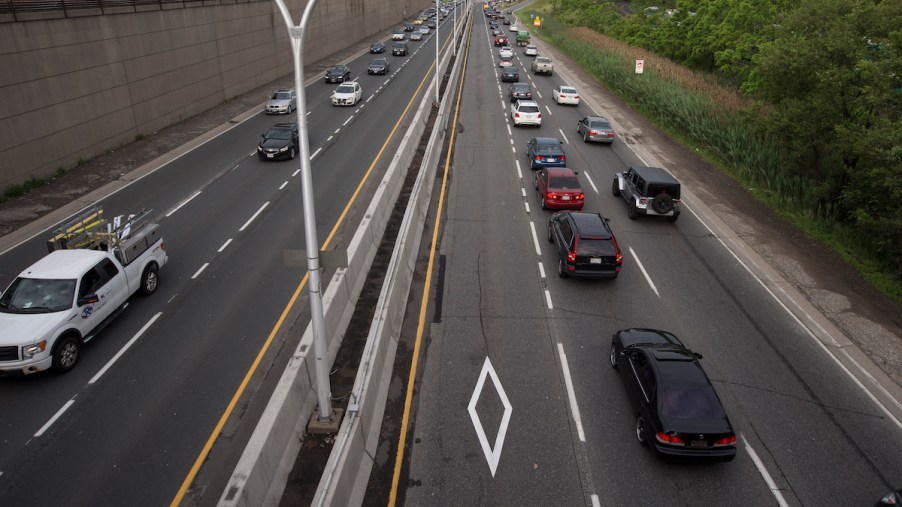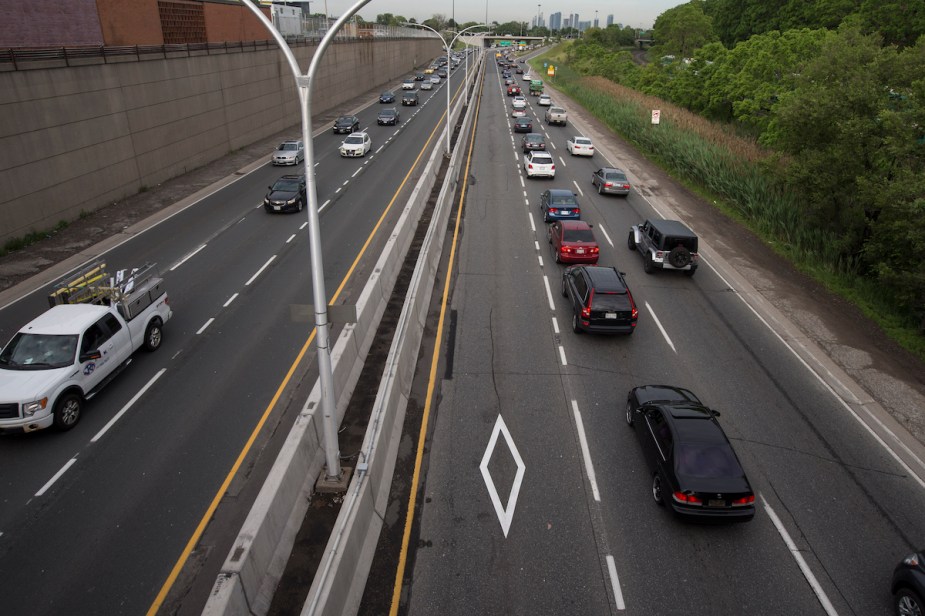
What Is an HOV Lane, and What Does ‘HOV’ Stand For?
In early July, a pregnant Texas woman was stopped for driving in an HOV lane. A deputy ticketed the woman for allegedly breaking a cardinal rule: Cars traveling in HOV lanes must have two or more people. However, the woman, Brandy Bottone, surprised the deputy when she argued that because she was pregnant, the baby should count as a person. So, with HOV lanes in the news lately, you might wonder, what is an HOV lane? And what does “HOV” stand for?
Pregnant woman’s traffic stop highlights recent political issues

In an interview with CNN, Brady Bottone recounted her interaction with a Dallas County Sheriff’s deputy over HOV rules. “‘There’s two of us,'” she said she told the deputy when he stopped her car. “He said, ‘Well, it’s two bodies outside of the body, so that doesn’t count.’ I was kind of in shock, and I was like, ‘Well, in light of everything that’s happened, and I’m not trying to make a huge political stance here, but do you understand that this is a baby?'”
The Dallas Morning News first reported on Bottone’s interaction with the deputy. The story came merely days after the Supreme Court overturned Roe v. Wade abortion protections. Bottone’s argument that her unborn child should be counted as a passenger “previews future legal battles related to the personhood of a fetus,” according to the article. Bottone’s traffic infraction suddenly became part of the pro-life/pro-choice debate, with most media sites linking the two in reports.
For example, The Dallas Morning News wrote, “She says she doesn’t believe the state should have it both ways. If a fetus is considered a life before birth, then why doesn’t that count as a second passenger?”
“But they still gave me a ticket,” Bottone continued. “So my $215 ticket was written to cause inconvenience? This has my blood boiling. How could this be fair? According to the new law, this is a life. I know this may fall on deaf ears, but as a woman, this was shocking.”
As CNN pointed out, the idea of the HOV lane is to promote carpooling and “cut down on traffic and emissions.”
But the story still has many wondering whether a pregnant woman can legally drive in the carpool lane.
What does ‘HOV’ stand for, and what are the rules of HOV lanes?
“HOV” stands for”high-occupancy vehicle.” And an HOV lane is a section of road reserved for vehicles with a driver and one or more passengers. Depending upon the jurisdiction, it might be called a commuter lane, diamond lane, carpool lane, or HOT (high-occupance toll) lane. Jurisdictions can impose temporary or permanent restrictions depending on traffic demands.
Permanent HOV lanes can be separated by physical barriers from the primary lanes of traffic. For example, outside of rush hour, such lanes could be restricted to emergency vehicles, public transit, or public works. Diamond lanes are usually the right-most or left-most lanes, with many states allowing scooters and motorcycles. Temporary HOV lanes are sometimes marked using road signs and/or pylons.
In recent years, more cities have allowed low-emission vehicles such as hybrids and all-electric cars to use HOV lanes with a single person. According to the U.S. Department of Energy, “Vehicles must be certified by the U.S. Environmental Protection Agency (EPA) and appropriately labeled for use in HOV lanes. The U.S. Department of Transportation (DOT) is responsible for planning and implementing HOV programs, including the low-emission and energy-efficient vehicle criteria EPA established.”
The federal government allows states to choose whether to adopt those requirements. However, they’re responsible for vehicle labeling and enforcement. Energy-efficient and low-emission vehicle toll exemption expired on September 30, 2019. And HOV lane exemptions for alternative fuel vehicles (AFVs) and plug-in electric vehicles (PEVs) expire on September 30, 2025.
HOV lanes started in the early 1970s
In 1969, the first highway HOV lane opened in Northern Virginia on the Henry G. Shirley Memorial Highway between the Capital Beltway and Washington, D.C. It was a bus-only lane, likely to allow workers to travel to D.C. in a reasonable time. In December 1973, HOV lanes were opened to vehicles with four or more people. It was the first example of an HOV lane that buses and carpools shared over some distance.
Throughout the 1970s, the Federal Transit Administration (FTA) acknowledged the benefit of HOV lanes and promoted funding. During the same period, the Federal Highway Administration (FHWA) also began allowing states to use federal funds to implement HOV lanes. Among other factors, the National Ambient Air Quality Standards provided the Environmental Protection Agency (EPA) with significant authority to regulate air quality. Furthermore, studies showed that ridesharing improved overall U.S. car safety.


